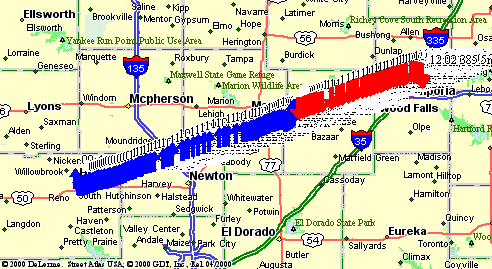| Flight Parameters | |
|---|---|
| Launch Date/Time | Thursday, 2 May, 2002 at 9:00am |
| Alternative Date | 6 or 7 May 2002 |
| Launch Site | Wiley School (38º 04.6'N, 97º 56.9'W) in Hutchinson, KS |
| Primary Transmitter / Antenna | VX-1R HT running APRS on 144.39MHz / Vertically polarized dipole |
| Backup Transmitter / Antenna | PC Electronics 1.5W ATV Transmitter on 434.00MHz / Horizontally polarized Little Wheel antenna. |
| Backup Transmitter / Antenna | Keyed oscillator on 147.55MHz (no modulation) / Horizontally polarized dipole |
| Balloon / Gas | Kaymont 1200gram / 240 cu feet of Helium |
| Estimated Burst Altitude | 93,000' MSL |
| Estimated Ascent Rate | 1300' per minute |
| Estimated Descent Rate | Approx. 1400' per minute at touchdown |
| Capsule(s) weight | 5lb 11oz (2577g) including parachute, rigging, batteries, etc... |
| Chase Frequencies | 147.12+, 146.82-, 146.52MHz, 7.2535MHz |
Flight Results
The school launch was basically a text-book launch and recovery. Most systems worked flawlessly, but we did have a few surprises. The kids loved the event and I think we left a very good impression on them.
| Flight Statistics | |
|---|---|
| Launch Date/Time | Thursday, 2 May, 2002 at 9:41am |
| Launch Site | Wiley School (38º 04.29'N, 97º 54.65'W) in Hutchinson, KS |
| Burst Altitude | 104,150ft (31,745m) MSL |
| Average Ascent Rate | 1196ft/min (6.08m/s) |
| Measured Descent Rate | Approx. 870ft/min (4.42m/s) at touchdown |
| Touchdown Site | 7 miles northeast of Emporia, KS (38º 29.3877'N, 96º 06.6215'W) |
| Touchdown Time | Thursday, 2 May, 2002 at 11:43pm |
| Recovery Time | Thursday, 2 May, 2002 at 12:03pm |
| Distance Traveled | 102 miles as the crow flies |
| Total Flight Time | 2 hours 02 minutes |
| Downloads | Lat/Lon File, Flight Analysis |


Lessons Learned
- Having dedicated APRS tracking stations ready to go helped the pre-launch stress. Zack's FT-2700 and TNC are mounted inside of a tool box with antenna, power, and data connections on the side. APRS setup took about two minutes instead of 10-20 minutes when I was robbing parts from other systems around the house. I think it's also far more reliable since I don't have a bunch of exposed connections.
- The Little Wheel antenna seemed to perform fairly well, but we still aren't seeing the distance we were hoping for. I think an investment in a large antenna and a good pre-amp is the next step.
- I had been over-estimating our descent rate. This was the first flight where we good data logs just before touchdown. In the past, we had estimated about 1400ft/min but it appears from the initial analysis, that we are actually slowing to under 900ft/min.
- The APS camera exposed almost all frames of film while still sitting on the ground. This was the same problem we saw on PT2002a. The problem is related to RFI and we thought we had improved the situation, but apparently not. The next step is shield cables and possibly an opto-isolator on the shutter button.
- We again increased the number of packets sent per minute which helped our overall tracking ability. We now transmit GPGGA, GPRMC, wait 30 seconds, GPGGA, GPRMC, telemetry packet, wait another 30 seconds. This configuration produces a lot of traffic, but gives us reliable positioning information every 30 seconds.
- The 50lb-test Kevlar SpiderLine 'weak link' was again broken upon recovery. Since we had not had a valid sucessful test (i.e. 2002a), we flew with a slightly longer 50lb-test monofilament backup. The monofilament was not broken, but the Kevlar line broke right at the knot where it was epoxied.
